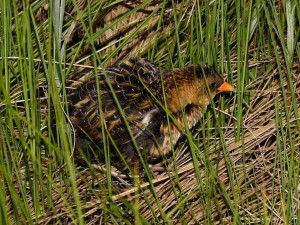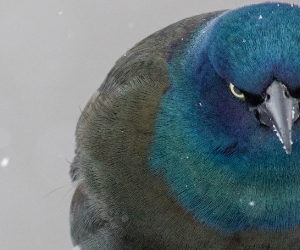Species Spotlight: Yellow Rail
Get to know some of the species at risk in the Lac Deschênes IBA with the Species Spotlight, aka “Sp-Spot”. Today meet the: Yellow Rail

Yellow Rail
Photo by Dominic Sherony
Scientific Name: Coturnicops noveboracensis
SARA status: Special Concern
Taxonomic Group: Birds
Size: length of 13-18 cm, wingspan of 28-32 cm
The Yellow Rail is a small marsh bird with an elusive nature. Only slightly larger than a sparrow, they are recognized by their yellow face and chest. They are yellow and black striped above with white flashes on the upper wing. Their bill is short and yellow and they have a dark crown and dark stripe through the eye. This colouration allows them to camouflage with the habitat they live in, making them difficult to see. Yellow Rails feed on insects, snails, crayfish, tadpoles, grasses and reeds. They are found in wetlands that are dominated by grasses and sedges, with a low water level, as they nest on the ground. Due to their secretive nature little is known about their life history.
Where Else Can You See This Species?
During the breeding season Yellow Rails are found in wetlands from Alberta and southern Northwest Territories, east to the Maritimes and south to the northeastern United States. The Yellow Rail overwinters in salt marshes and rice fields along the southeastern coastal United States, from North Carolina to Texas. The can be found in their breeding grounds from late April to early September. Around the Ottawa area you can find Yellow Rails in the Richmond Fen, where there is a breeding colony. Yellow Rails are infrequently seen in the Lac Deschênes IBA and Mud Lake.
Did You Know?
• The biggest threat to the Yellow Rail is habitat loss. Wetlands are often drained for agricultural or urban development, destroying breeding grounds.
• The young are semi-precocial, which means they are able to leave the nest soon after hatching. At two days old they leave the nest with their mother. At five days old they are capable of feeding themselves and at 35 days old they are able to fly.
• Males make a distinct clicking sound, “tic-tic, tictictic”. The sound resembles two stones being banged together. This call is often heard at night.
Check back every week to read about a different species at risk that can be found in Lac Deschênes.
You can report sightings of this and other rare species to the Canadian Wildlife Service at (819) 997-2800 or on the MNR Natural Heritage Information Centre website. A photo and a location are very helpful!
We would like to thank our guest blogger Michelle Locke for this post. Michelle is a contract research technician at the Canadian National Collection of Insects, Arachnids and Nematodes. She studies flies of the family Syrphidae, the flower flies, but enjoys opportunities to work with and study all other forms of wildlife when she can.




